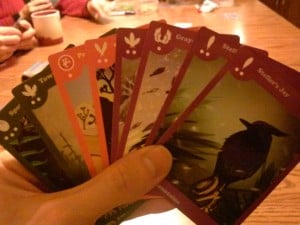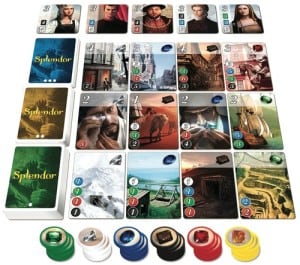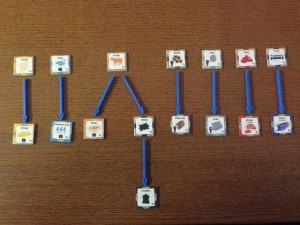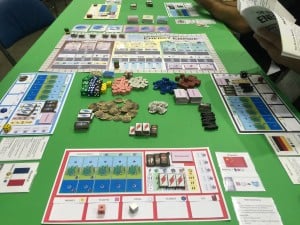
Today I continue my investigation of the core elements of games with resources. If you missed my previous articles, you can see them here: Game Elements: Goals, Game Elements: Scoring, and Game Elements: Actions
Even the simplest games involve some amount of resource management, if only in how players manage their time. At the other end of the spectrum, many games, especially heavier Euro games, feature complex resource management at their cores. Today I will cover some of the many ways resources are used in games to enhance gameplay.
WHAT ARE RESOURCES?
BY DEFINITION, RESOURCES ARE LIMITED BUT ENABLE PLAYERS TO ACT IN NEW WAYS.
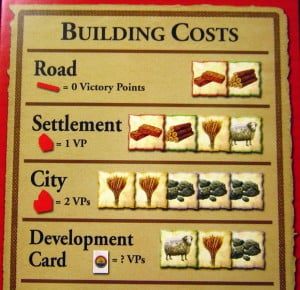
In Catan, players cannot construct buildings without the correct resources.
This is a pretty broad definition, but it does eliminate one important thing in particular: in many games, victory points are not resources, because they do not enable the player to act. Dominion is a great example of this. Most of the victory point cards in Dominion actually hinder the player, a striking difference from the other cards in the game.
This is not a hard and fast rule, however. In Corporate America, players can freely exchange money (victory points) to influence other players. Without the money, a player would not be able to act in that way, so money is a resource.
OPPORTUNITY COSTS
The ultimate resource in every game is time (just like in life). Though it may not seem like it on the surface, many games are all about using this resource as efficiently as possible. In 7 Wonders, for example, each player gets 18 turns, and the player that can convert her turns into the most points is the winner.
In many games, the length of the game is not predetermined, but is random or partially determined by the players. In these games, much of the fun comes from being uncertain about how much time players have, and skilled players can better judge how much of this resource they have left.
UNUSUAL RESOURCES
Many games include resources that, like time, might not obviously be resources at first glance. For example, cards in many games are effectively resources, sometimes very explicitly like in Race for the Galaxy. In other games, hit points, units, or territory can be used as resources. Turning something that might not seem like a resource into one is a fun way to make players think about the game a little differently. Unusual resources can also be a great way to make special actions feel special.
In Birds of a Feather, cards aren’t just birds, they’re limited tickets to visit different locations.
RENEWABLE RESOURCES
In some games, resources can only be used once. This is very common for games with money, or where gathering resources is a core part of the game. The tokens in Splendor are a good example of these non-renewable resources. With such games, some players will avoid spending their resources (chalk it up to loss aversion), so you might need to include a mechanic to push players towards using their resources.
In other games, resources can be used repeatedly, often once per turn. The gems from cards you’ve purchased in Splendor serve this role. In this case, loss aversion will actually encourage players to spend their resources rather than hoard them. However, it’s important that players gain their renewable resources at about the same rate. If one player starts to fall behind, that disadvantage will be exacerbated over the course of the game, souring much of the play experience.
Splendor uses both renewable and non-renewable resources.
PACING WITH RESOURCES
Resources can be a great way to pace a game. Players start with few resources and can do very little, but over time they accumulate more, which enable more and more powerful actions. This will give players a sense of progression and will help make the game feel like it’s building up to a climax. This is especially true for renewable resources which continue to accumulate over the course of a game.
Single use resources tend to have a more cyclical nature as players collect resources, spend them, then restart the cycle. There can still be an overall trend towards more powerful actions, however, if players spend their resources on engine pieces that make it easier to accumulate resources or open up more powerful actions.
COMPLEX ECONOMIES
In some games, time is your only resource. In others, there is a single currency resource to manage. But many games feature many different resources, and part of the fun comes in juggling them all.
When a game features multiple resources, it’s not uncommon for those resources to be layered in some way. For example, a player might gather raw materials, then convert them into more specialized goods, which ultimately are spent on special abilities, victory points, or even more resources. When working on a game with multiple resources, it’s important to differentiate how they’re acquired or spent to make them feel unique and interesting.
Games with many different resources that relate to each other in complex or layered ways are both difficult to design and understand. For some players, they provide a welcome puzzle. For others, they are a confusing and unpleasant source of stress. Make sure you know your audience when designing the resource system for your game. And make sure you playtest such games many, many times. It’s very easy for imbalances to sneak into such complex systems.
In Le Havre, resources relate to each other in a layered fashion.
RESOURCES AND CORE MECHANICS
When resources are at the center of games, they can enable a lot of classic mechanics. Bidding, bluffing, trading, and many other interactive mechanics are supported by a strong resource system, and often fall flat without one. And complex resource systems can create intermediate goals for players and puzzles for them to solve, which can form the core fun of a game.
However resources fit into your game, remember that ultimately resources are about choice. Make sure your players have options about how they can spend their resources, and for some games, the option to not spend resources should be a serious consideration.
DESIGNING ARTIFICIAL ECONOMIES
When you start working on the resource system for a new game, ask yourself some basic questions. What role should this resource system have in the game? Should it be a focus and source of fun? Or is it there to support other mechanics, be it by managing the overall pacing of the game or balancing alternative player options? If the resource system is not intended to be the main focus of the game, I strongly encourage you to try to develop the simplest system you can that will get the economy’s job done.
Other questions to ask involve how constrained the players should be. You probably don’t want your players to feel frustrated because they never have enough resources, but, on the other hand, you need to make the resources actually matter by sometimes making them constrain player options.
Answering these questions and tuning an artificial economy can take a long time and a lot of testing. Don’t skimp on playtesting when it comes to resource systems!
In Manhattan Project: Energy Empire, players must balance many resources: money, plastic, steel, science, oil, workers, energy, and even a clean environment.
RESOURCE MANAGEMENT
All games involve some degree of resource management. When designing your game, pay special attention to how resources fit into the game. What do your target players expect and want? Should the resources be front and center, or hide in non-obvious places? How can resources be employed to help balance the game, control the game’s pacing, and enable player interaction? Is managing resources fun in the game, or a chore to support other types of fun? Answer these questions, then take the time to seriously playtest your economy!
Did I miss any important points about resources? Are there any games that make especially novel use of resources you think other designers should consider? Let me know in the comments below!

